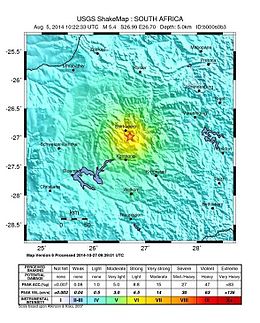2014 Orkney earthquake

|
|
| Date | 5 August 2014 |
|---|---|
| Origin time | 12:22:33 SAST (UTC+02:00) |
| Magnitude | 5.5 ML |
| Depth | 5.0 km (3.1 mi) |
| Epicenter | 26°58′18″S 26°42′34″E / 26.9717°S 26.7094°ECoordinates: 26°58′18″S 26°42′34″E / 26.9717°S 26.7094°E |
| Areas affected | South Africa, also felt in Botswana, Swaziland, Lesotho and Mozambique |
| Max. intensity | VI (Strong) |
| Foreshocks | 4.9 MW at 16:16:25 SAST on 15 June 2014 |
| Aftershocks | 3.8 ML at 16:58:42 SAST on 5 August 2014 |
| Casualties |
1 dead 34 injured |
1 dead
The 2014 Orkney earthquake occurred at 12:22:33 SAST on 5 August, with the epicentre near Orkney, a gold mining town in the Klerksdorp district in the North West province of South Africa. The shock was assigned a magnitude of 5.5 on the Richter scale by the Council for Geoscience (CGS) in South Africa, making it the biggest earthquake in South Africa since the 1969 Tulbagh earthquake, which had a magnitude of 6.3 on the Richter scale. The United States Geological Survey (USGS) estimated a focal depth of 5.0 km (3.1 mi). According to the USGS, the earthquake was "severely dangerous" as the epicentre was located near Orkney and Klerksdorp. The CGS reported 84 aftershocks on 5 August and 31 aftershocks on 6 August, with a magnitude of 1.0 to 3.8 on the Richter scale. According to the CGS, the earthquake is the biggest mining-related earthquake in South African history.
While earthquakes are uncommon in South Africa in general, the earthquake occurred in a mining belt where earthquakes are relatively common. The CGS had described a 2005 earthquake with a magnitude of 5.3 on the Richter scale in the same area as Orkney as "the largest mining-related earthquake in South Africa". The earthquake occurred on 9 March 2005 at DRDGOLD's Hartebeesfontein mine in Stilfontein, killing two miners underground and resulting in the closure of the mine. An investigation by the mining regulator following the incident found that it was caused by mining and further seismic events would occur while mining continued. The report on the investigation recommended improvements in seismic monitoring among other things, and some of the recommendations had been implemented before the 2014 earthquake. The USGS recorded a 4.9 moment magnitude earthquake on 15 June 2014 in the same area, which earth science consultant Dr Chris Hartnady believes may have been a foreshock.
...
Wikipedia

